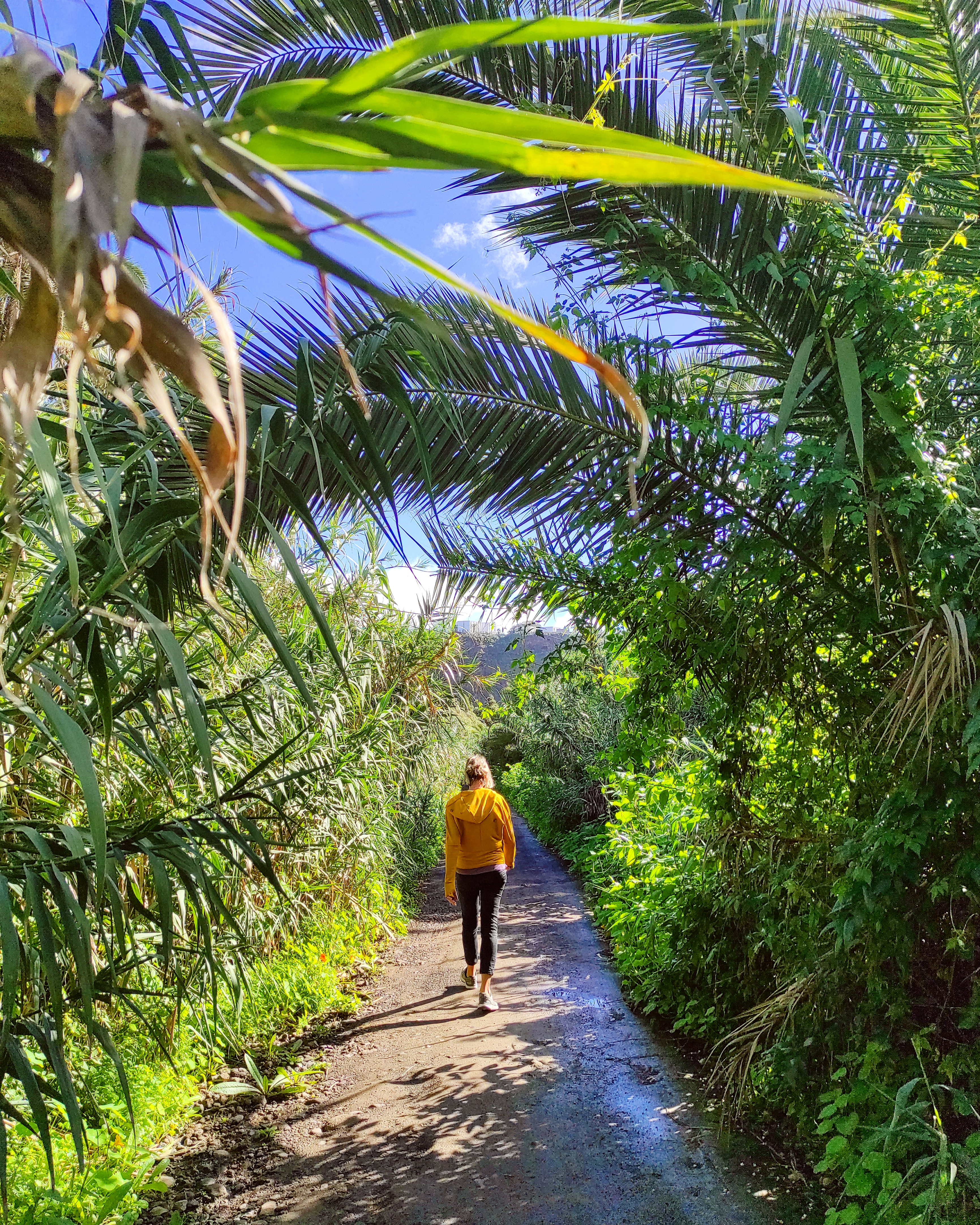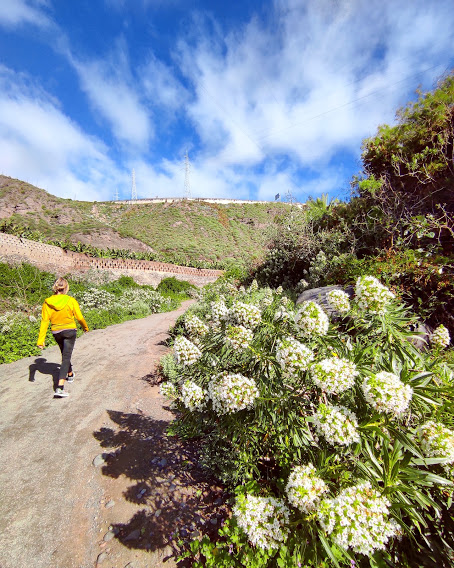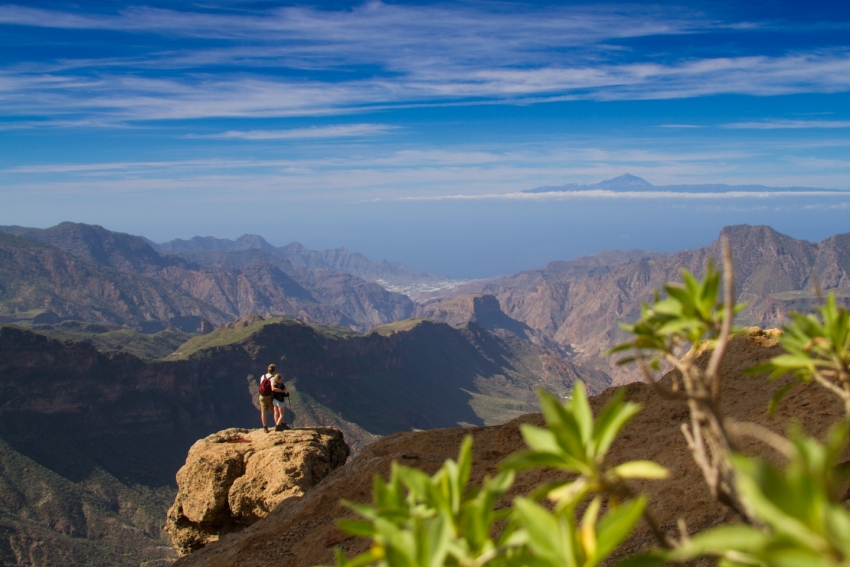Finding The Lady of Bandama: A Unique Species
You have to up early and very lucky to find the Bandama Caldera full of mist like in Lex's photo. It only happens a few days every year and clears as soon as the sun starts to warm up.
However, there is a lot of stuff to see and do in and around the caldera other than drive to the top of the cinder cone and look at it. You can walk around it, down to the crater floor, visit the aboriginal caves, and the secret bunker (when the visitor centre reopens).
The Lady Of Bandama
A few days ago we walked down to the caldera floor to find something truly unique.
Parolinia glabriuscula, know as the Dama de Bandama or Bandama Lady, only grows inside the walls of the caldera. In fact, it only grows on the cliffs at the southeastern end of the caldera and on the scree at its base.
To be honest, the Dama isn't the most exciting plant in the world to look at. It's similar to other Parolinias growing in other places around the island (Guayadeque, the southern slopes of the island, etc).
What makes it special is that it is critically endangered and only grows in a tiny area: Definitely unique enough to walk across the Caldera floor to find; especially in January to March when it produces its little white flowers.
It seems to be thriving now that goats no longer graze inside the Caldera (and now the aggressive donkey has gone). There are far more plants than I remember when I was a kid and they have spread down the scree slope and almost onto the floor. Good news that is being repeated all over the island now that most goats are kepet bpenned in rather than roaming free.
ALEX SAYS: I was with my mother, a botanist, when she discovered the Dama de Bandama back in the 1980s. We were walking around the crater rim and spotted the only one growing outside the caldera.
Everything you need to know to walk down to the caldera floor is in our Gran Canaria map. We haven't marked the caves because we want to go back and make sure they are still safe to reach.
Note that the Hoyos de Bandama winery tends to have fairly erratic opening houtrs so if you see it open, head in for a glass of wine. The Caldera dry white is one of Gran Canaria's best.
White Flower Walk In Las Palmas' Only Wild Valley
 Late January and early February is the perfect time to explore Las Palmas' only remaining wild valley; The Guiniguada Barranco. It's when it's at it greenest and the white echium bushes are in full flower.
Late January and early February is the perfect time to explore Las Palmas' only remaining wild valley; The Guiniguada Barranco. It's when it's at it greenest and the white echium bushes are in full flower.
It's an easy walk between Triana and Santa Brigida past the Jardín Canario botanical garden. The path has recently been widened so you can now walk or mountain bike all the way to Santa Brigida town without having to scamble over the barranco floor.
From the start of the trail by Triana, it is 8.8km to the Maipez bar just below the Jardín Canario. From here you swap into the Barranco de Santa Brigida and a further three kilomtres takes you past La Calzada village to arched bridge popular with bungee jumpers. The trail continues for 5km up the wide valley floor all the way to Santa Brigida past Angostura and Las Meleguinas villages.
 The lower part of the trail goes past banana plantations before the valley gets wilder and you leave the ridgetop houses of Las Palmas behind. The top half is greener and narrower with more banana plantations and some big houses. Between the Maipez and the Angostura bridge the barranco is narrow and steeper while the ñast part is a is a mix of fruit orchards, farms and palm groves.
The lower part of the trail goes past banana plantations before the valley gets wilder and you leave the ridgetop houses of Las Palmas behind. The top half is greener and narrower with more banana plantations and some big houses. Between the Maipez and the Angostura bridge the barranco is narrow and steeper while the ñast part is a is a mix of fruit orchards, farms and palm groves.
There are no shops or toilet facilities along the way so take plenty of water and snacks. The trail is wide and not steep although bits of it are cobbled and awkward on a bicycle. The top half of the walk has several picnic sites with shade and benches.
 Normally, you can keep walking along the roadside to the bottom entrance of the Jardín Canario, then up through the garden to the bus stop for a ride back down to Las Palmas. However, the JC is only open via the top entrance at the moment betwenn 09.00 and 14.00.
Normally, you can keep walking along the roadside to the bottom entrance of the Jardín Canario, then up through the garden to the bus stop for a ride back down to Las Palmas. However, the JC is only open via the top entrance at the moment betwenn 09.00 and 14.00.
If you want to stop walking at the Maipez (9km from Triana) the best option is to call a taxi (less than 10 euros back to the city). The Maipez itself is still open although you aren't allowed inside at the moment. Its devilled eggs (huevos rellenos) are a good snack after a long walk.
The best radio taxi service in the area is TARA: 928 460 000
Nature Notes
 Every January the Guiniguada Valley explodes into colour as the white echiums flower alongside daisies and nasturtiums.
Every January the Guiniguada Valley explodes into colour as the white echiums flower alongside daisies and nasturtiums.
The echiums in the Guiniguada are Echium decasnei with white flowers but you do get the odd blue plant as well (see photo right). In the lower part of the Guayadeque Valley many of the E. decasnei have blue flowers.
The palm trees in the lower part of the valley are nesting sites for ring-necked parakeets and there are pairs of kestrels all along the trail; we saw two mobbing a buzzard. Gran Canaria blue tits, chiffchaffs and Berthelot's pipits (running along the ground) are common.
Big Plans For Gran Canaria's Coastal Paths Need Madrid Approval
Gran Canaria's coastal paths are amongst it's most popular public spaces, but many need a good revamp. Here's the plans that are in the pipeline.
Gran Canaria Walking: World Class Hikes All Year Round
You don't know Gran Canaria until you've got off the tarmac and walked its world-class hiking trails.
Resort Walks with Gorgeous Sea Views in Gran Canaria
Millions of people come to Gran Canaria every year for its beautiful beaches and perfect weather. Some of you however, want to do a bit more than just get a tan. If you fancy going for a walk in Gran Canaria, but don't want to go too far from the resorts, don't worry: There are plenty of excellent walks right in the heart of Gran Canaria's main resorts.
Walking in Gran Canaria ranges from sunset strolls by the sea to epic treks across the mountains. Here’s our guide to the resort walks in Gran Canaria that combine easy walking with plenty of outdoor cafes and ocean views.
Across the Maspalomas Dunes
The dunes are Europe's only slice of the Sahara Desert. They stretch over 6km from Maspalomas resort to Playa del Ingles. The best way to see them is to walk right across them from the end of Avenida Tirajana to the sea.
See here for a Google Map of the start point for this walk.
The walk takes an hour with a couple of stops for taking photos and running up and down sand dunes. The soft sand is hard going so stick to the crests of the dunes for the easiest path. Take water, a hat and sunscreen.
Once you reach the sea either walk west along the beach back to Maspalomas or east back to Playa del Inglés. We recommend doing the walk at dawn or dusk as you will get better photographs and it won't be as hot.
Beach walking from Maspalomas to Playa del Inglés
If walking through the dunes sounds like too much hard work, then walk along the shore from Maspalomas to Playa del Inglés resorts, or vice versa.
Start either in Maspalomas by the lagoon, or from the Annexo 2 line of restaurants on the beach in Playa del Inglés. The walk is about 6 km long and takes a couple of hours with a stop for a swim, some sunbathing, or a drink at one of the many snack stands on the beach.
You’ll go past the nudist sections of the beach so don't be surprised if you see a few naked people splashing about in the sea or playing volleyball on the beach (what is it with nudists and volleyball?).
The Costa Canaria Walk
You don't even have to get sand in your sandals to walk along the beachfront in Playa del Ingles. The beachfront promenade, called the Paseo Costa Canaria, runs all the way from the end of Avenida Tirajana to San Agustín Beach about 5km east. The whole walk is dune- or seafront and takes you past a couple of quiet, local beaches.
Walking from Playa del Inglés the promenade, which is largely wheelchair friendly, runs behind the dunes and past the three small, sheltered beaches called Playa El Cochino at the end of Playa del Ingles beach.
The walkway continues along the coast to Las Burras Beach with its golden sand and largely local crowd and goes on all the way to San Agustin Beach and up the hill to the end of San Agustín Resort. The whole walk takes a couple of hours one way if you include a drinks stop or a swim at one of the beaches.
Meloneras Promenade
The Lugar las Meloneras seafront promenade is in the newest and most upmarket part of Gran Canaria's resorts. It runs between the historic Maspalomas lighthouse, soon to open as a museum and exhibition centre, all the way to Meloneras Beach. The walk takes you past plenty of shops, bars and restaurants, and past a tiny archaeological park right on the seashore.
Lugar las Meloneras is a great place to walk in the evening as you get to watch the sea set over the Atlantic Ocean. Meloneras Beach itself gets ignored by most visitors in favour of bigger Maspalomas Beach. It is sandy and has its own little shopping centre with bars and restaurants. If Maspalomas beach is windy, there is a good chance that Meloneras will sheltered enough to sunbathe.
From Puerto Rico to Amadores Beach
The safe, cliff-top walk from Puerto Rico resort to Amadores Beach gives you beautiful views of the turquoise sea and rocky shore along the way. There is even a spiral stair case in front of the Gloria Palace Hotel that takes you down to the sea. If the sea is rough, which isn't that often, don't go down the staircase as people have been washed off the rocks during storms.
The walk starts from the shopping centre in Puerto Chico. It takes about 40 minutes one way. Once you get to Amadores Beach you can get a drink or a snack in one of the restaurants, go for a swim and do a spot of sunbathing, and then either walk or take a taxi or bus back to Puerto Rico.
These walks may not take you up into rugged Gran Canaria mountains, or past any rural villages but they give you amazing views of the sea and have plenty of convenient drink stops.
Gran Canaria Beaches: The Legendary Güi Güi
If Güi Güi beach was next door to Maspalomas nobody would think twice about it. It's not particularly pretty and at high tide most of it is underwater. The sand is on the dark side and disappears completely during the winter. At times it is covered in driftwood. Nevertheless, Güi Güi's remote location and high cliffs make it Gran Canaria's Shangri La.
Gran Canaria Info recommends:
- Default
- Title
- Date
- Random


















